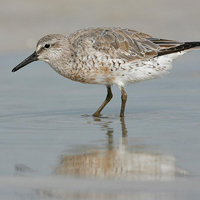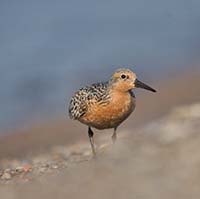Red Knot rufa subspecies
Scientific name: Calidris canutus rufa


Photo credits: Brian E. Small (left), and Timothy Haan (right)
Status
Endangered: Southeastern USA / Gulf of Mexico / Caribbean wintering population and Tierra del Fuego / Patagonia wintering population
"Endangered" means the species lives in the wild in Ontario but is facing imminent extinction or extirpation.
Special Concern: Northeastern South America wintering population
"Special concern" means the species lives in the wild in Ontario, is not endangered or threatened, but may become threatened or endangered due to a combination of biological characteristics and identified threats.
Date added to the Species at Risk in Ontario List
Red Knot rufa subspecies was added to the Species at Risk in Ontario (SARO) List as an endangered species on February 19, 2009.
In 2021, the Committee on the Status of Species at Risk in Ontario recognized the species as having three separate designatable units in Ontario, which are primarily distinguished by their different overwintering grounds, along with differences in their morphology and genetics. Each designatable unit was classified as at risk in Ontario and added to the SARO List on January 25, 2023.
- Assessment report for Northeastern South America wintering population [PDF].
- Assessment report for Southeastern USA / Gulf of Mexico / Caribbean wintering population [PDF].
- Assessment report for Tierra del Fuego / Patagonia wintering population [PDF].
What it looks like
Red Knot is a plump, medium-sized shorebird (about 23-25 centimetres long) named for its brick-red face, throat and breast when in breeding plumage.
Its back is speckled grey-brown and its short, straight beak is black. In winter, these birds are mostly grey with a whitish belly.
Young birds look similar to winter adults but usually have a faint salmon-pink or peach wash on their chest.
The rufa subspecies shows a lighter red breast than the Red Knot roselaari and islandica subspecies.
Where it lives
Red Knot rufa subspecies breed within the central Canadian Arctic before travelling thousands of kilometres south to overwinter.
The Northeastern South America designatable unit of Red Knot rufa subspecies overwinters primarily in coastal areas of Brazil, with a small proportion in small groups in French Guiana and Suriname.
The Southeast USA / Gulf of Mexico / Caribbean designatable unit of Red Knot rufa subspecies overwinters in coastal areas of Florida, Louisiana, the Texas/Mexico border region, and islands in the Caribbean Sea.
The Tierra del Fuego / Patagonia designatable unit of Red Knot rufa subspecies overwinters in coastal areas of Patagonia, including areas on the northern coastline of Tierra del Feugo, and further north in the San Jorge Gulf.
During migration, the subspecies prefer open beaches, mudflats, and coastal lagoons, where they feast on molluscs, crustaceans, and other invertebrates.
Where it’s been found in Ontario
The Red Knot rufa subspecies only occurs in Ontario during migration, where it may feed and rest on beaches.
The coastal mudflats along the southwest coast of Hudson Bay and James Bay in northern Ontario are very important staging sites (where birds stop to refuel) during both spring and fall migration.
They are also regularly seen in small numbers during the fall in southern Ontario, usually along Great Lakes beaches and mudflats.
Occasionally, large flocks have been seen in spring at select eastern Ontario beaches, such as Presqu’ile Provincial Park and Amherst Island, when birds flying non-stop from Delaware Bay to James Bay are forced to land because of bad weather.
What threatens it
The main threat to the Red Knot rufa subspecies is loss of food at key migration sites.
It times its spring migration to consume Horseshoe Crab eggs laid in Delaware Bay, and the unregulated commercial harvest of Horseshoe Crabs has resulted in a lack of food and a steep population decline.
Other threats include:
- predation and disturbance from increasing falcon populations
- possible impacts of climate change such as shifting weather patterns and rising sea levels
Action we are taking
As endangered species, the Southeastern USA / Gulf of Mexico / Caribbean wintering population and Tierra del Fuego / Patagonia wintering population of Red Knot rufa subspecies receive species and habitat protection under Ontario’s Endangered Species Act, 2007 (ESA).
The ESA also requires us to prepare recovery guidance for endangered species.
As a special concern species, the Northeastern South America wintering population of Red Knot rufa subspecies does not receive protection under the ESA, but the act requires the preparation of recovery guidance for the species unless a recovery strategy or management plan is required under the federal Species at Risk Act.
All species listed on the Species at Risk in Ontario List may be eligible for consideration for government funding through the Species at Risk Stewardship Program.
Recovery strategy
A recovery strategy advises the ministry on ways to ensure healthy numbers of the species return to Ontario.
Read the executive summary and the full document (December 7, 2018)
Government response statement
A government response statement outlines the actions the government intends to take or support to help recover the species.
Read the government response statement (September 5, 2019).
Habitat protection
General habitat protection — February 18, 2010
General habitat protection applies to the Tierra del Fuego / Patagonia wintering population and Southeastern USA / Gulf of Mexico / Caribbean wintering population.
What you can do
Report a sighting
Submit your observations of species at risk to the Natural Heritage Information Centre (NHIC), which is Ontario’s conservation data centre. Join the “(NHIC) Rare Species of Ontario” project in iNaturalist to make submitting your observations quick and easy.
Birds Canada is working to advance the understanding, appreciation and conservation of wild birds and their habitat in Ontario and elsewhere; for more information on how you can help, visit the organization’s website.
Volunteer
Volunteer with species at risk programs, such as community science surveys, through your local nature club, a provincial park or other conservation organizations.
Be a good steward
Private landowners have a very important role to play in species recovery. If you find species at risk on your land, you may be eligible for stewardship programs that support the protection and recovery of species at risk and their habitats, such as the Species at Risk Stewardship Program.
Report illegal activity
Report any illegal activity related to plants and wildlife to
Quick facts
- The Red Knot rufa subspecies undertakes very long migrations; they travel all the way from breeding areas in the central Canadian Arctic to southern South America, a distance of nearly 15,000 kilometres.
- Red Knot rufa subspecies eggs are very well camouflaged and blend in well with the bare tundra; this is important because Red Knot rufa subspecies nests are only shallow depressions in the ground and don’t offer much protection or concealment from predators.